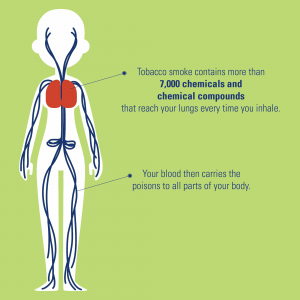 Quitting tobacco is the most important step you can take to improve your health.
Quitting tobacco is the most important step you can take to improve your health.
We’re guessing you agree with that because you’ve tried already – and maybe many times. Trust us … you are not alone. Quitting tobacco is hard. The average quitter makes many quit attempts before they actually stay tobacco-free.
And it isn’t just about will-power. Nicotine addiction keeps people smoking even when they want to quit. Keep in mind the tobacco industry wants to keep you addicted and they’ve engineered tobacco products to make quitting hard – some of today’s cigarettes are more addictive than those from earlier decades.
 There’s good reason to quit now – compelling reasons. Damage from tobacco smoke is immediate.
There’s good reason to quit now – compelling reasons. Damage from tobacco smoke is immediate.
- These poisons damage DNA, which can lead to cancer; damage blood vessels and cause clotting, which can cause heart attacks and strokes; and damage the lungs, which can cause asthma attacks, emphysema, and chronic bronchitis.
- Smoking longer means more damage. Both the risk and the severity of many diseases caused by smoking are directly related to how long the smoker has smoked and the number of cigarettes smoked per day.
The good news? You CAN do it! So many others have quit – today, there are more Alaskans who have quit than there are smokers. They did it – now it’s your turn!
TIPS FOR QUITTING
Staying motivated, learning from your quit attempts, talking with your quit coach, leaning on supportive family and friends and following your quit plan are all ways to stay on track and avoid a relapse.
Combine resources for greater success
- Quit coaches will tell you firsthand how you can break habits by mixing things up and what to do when you get a craving.

- People who talk to their doctors about quitting or call Quitlines for advice are more successful than those who go it alone.
More tips for quitting
- Set a quit date, ideally within two weeks.
- Remove tobacco products from your home, car, and workplace.
- Resolve not to smoke at all—not even one puff.
- Avoid drinking while you’re quitting cigarettes. Drinking alcohol can trigger cravings for a cigarette.
- Anticipate challenges, such as nicotine withdrawal, particularly during the critical first few weeks.
- Ask others not to smoke around you. Allowing them to smoke around you can make it harder for you to quit.
- Identify reasons for quitting and benefits of quitting.
The benefits are well worth it. Keep trying.
Support to Quit
The following free resources are available to help smokers quit.
- 1-800-QUIT-NOW (1-800-784-8669) Alaska’s Tobacco Quit Line www.alaskaquitline.com
Free support and advice from experienced counselors, a personalized quit plan, self-help materials, the latest information about cessation medications, and more. - BeTobaccoFree.gov – the Department of Health and Human Services’ comprehensive Web site with general information on tobacco and evidence-based methods on how to quit.
- Smokefree.gov – supports the immediate and long-term needs of people trying to quit smoking.
- espanol.smokefree.gov – Spanish-language quitting site.
- asiansmokersquitline.org – Asian-language quitting site.
- Quit Tobacco: Make Everyone Proud – Web site for military personnel and their families.
- Help for Smokers and Other Tobacco Users: Quit Smoking – an easy-to-read guide
- How to Quit provides more useful information from CDC to help you quit.
- Facebook App: Be Smoke-Free—You Matter to Me!
If there’s someone in your life who could benefit from gaining independence from smoking, check out Be Smoke-Free—You Matter to Me! Facebook app. You can use it to remind him or her of all the activities and major life events they might miss out on if they continue to smoke—and more importantly, all the things they can look forward to after quitting. You can send a heartfelt message to show how much you care and to encourage and motivate them to try to quit.
